 Before you start investing
in the share market or share
trading, it is wise to adequately prepare. Before you start investing
in the share market or share
trading, it is wise to adequately prepare.
It is very useful to know "enough" about the markets - but how
much is
"enough"?
And what is really involved? Perhaps you have started
investing/trading
but without success?
Here is Robert's checklist to help you determine your level of
readiness.
It might look like a long list; but if you
can tick off every item, it will help you to be prepared.
Which financial instrument to trade or invest?
The discussion and information on this page is focused on share
market
trading and investing.
For simplicity, there are other financial instruments which are
not
mentioned here.
See
more information about alternative instruments (eg. bonds,
hybrids, forex, options, etc.)
Print this web page, and use it as a checklist - tick
the completed items, and circle the outstanding ones.
(Print it using the print option "shrink to fit".)
WARNING:
Investing in the share
market does
expose you to the risk of financial ruin.
If you proceed, please do so carefully.
This is not
advice of any sort. Always seek
professional guidance before taking action. |
|
Investing
or
trading in
the share market
is not for everyone.
And it is foolish to
rush in under-prepared.
There is a serious risk of loss of
capital. |
NOTE: This check list will not guarantee your
success,
but it will help prepare you
for the road ahead.
|
Summary Check list
(A) Preparation - Important things to
think about (see details below)
- Why do this? Is this for your?
- Your suitability
- Psychology and emotions
- Risk tolerance
- Funds and funding (where will the money come from?)
- Fundamental analysis or Technical Analysis?
- Funda-Technical Analysis
- Share price trends - The trend is
your friend
- How much news?
- Trading Styles, Plans and Strategies
- Trading Styles
- Trading Plans
- Trading Strategy
- Nimble Short Term Investing
- Allocate time and time slots (ie. time management)
- Understand the market and the instrument
- Your stock universe
- Understand your opponent and the counter-party
- Understand the market rules
- Paperwork
- Trading practise
- Back testing
- Paper trading
- Education
- How to trade?
- Broker and Trading Account
- Charting software
- Computer hardware
- Review
- Risk and money management
- Position sizing and position size
calculator
- Exit strategies
- Stop Loss
- Portfolio management
- Risk management
- More information...
(D) Trading - "pulling the trigger" (see
details
below)
- Trade planning
- Logon, select and trade
- Keep good records
- Be aware of and manage the emotions
(E) Trade Management - Monitor progress (see
details below)
- Monitor positions
- Periodic review of positions
- Scale down a position
- Periodic strategy review
(F) Investing / Trading Strategies (see
details below)
- Strategy considerations
- Sample strategies
See all the details below...
|
* Notes
and More Info
Many of the topics listed at left are expanded in Brainy's series
of eBook
(PDF)
Articles on Share Trading / Investing (see the list in
the left hand column).
Toolbox Members
- have access to the contents of the Share Market Toolbox. Some
materials are free; but much is reserved for subscribing Members.
More
details...
Robert
Brain provides support to new and
experienced traders and investors, including charting
software.
Why "Brainy"?
"I need to
differentiate myself and my products and services from
others in the
market place. So I am using one of the nicknames I had in
High School."
Who
is Robert Brain?
Brainy's
eBook
Articles
are fantastic value for money (free access included with
Toolbox Membership):
- The amount of information delivered each month is
just enough to easily digest without suffering information
overload.
- Better than buying another text book that you might
struggle to find time to read.
- File the information for easy future reference.
- If you have a special topic that you would like
covered, just email a request to Robert and maybe it can be
included.
Robert also runs seminars:

The toolbox is an arsenal
of weapons to help you tackle the share market.
See a list of contents on
the Toolbox
Gateway page.
The
Share Market
- more information about the market and investing and trading.
And whatever you do,
beware
the sharks in the ocean!
|
(A)
Preparation - Important things
to think about
- Why do this? Is this for you? - Think
seriously about why you might want to do this. Possible
reasons
include: taking
control, for enjoyment, to increase income, to build wealth,
etc. Or
perhaps just as a hobby for pocket money.
How seriously will you treat
it? The Australian Taxation Office has strong views about
the
degree of
seriousness.
See Brainy's eBook Article
ST-2000, "Preparation"
for an introduction to this topic (it's free), and
Article ST-2100, "Why
get into Share Trading?"
for some more details
[Toolbox members* can see the full version of ST-2100 here.]
- Your suitability
Find out
if you are suited to share market investing/trading - whether
short
term trading or
long-term investing. Some people have problems with the
worry of committing money to the share market. But there are
simple
ways to overcome this, such as keeping the amount of money "at
risk"
relatively
small (proper money management - see below). It is possible to
sleep at
night.

- Psychology and emotions
Understand the emotions and
psychology involved with this activity to help you stay in
control of your emotions whilst trading. The experts say that
a sound
psychological approach is about 80% of the
challenge in achieving success. There are strategies that can
be
implemented to help calm the nerves, stay in control, sleep at
night,
and protect investment capital. Read more about the underlying
emotions
and
psychology of the markets on this Toolbox web page on Emotions and
psychology.
Also see the "Risk
and money management" notes below.
A good book on this subject is
Mark
Whistler's "Trade with Passion and Purpose"
(picture at right).
Also see Brainy's eBook Article
ST-2120, "Psychology and emotions.
[Toolbox members* see the full version of ST-2120 here.]
- Risk tolerance
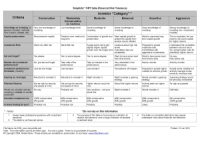
It is
very useful to understand your risk tolerance.
Robert has included a
self-assessment Financial Risk Tolerance table (FiRT)
in eBook Article
ST-2180, "Your risk profile and
tolerance".
[Toolbox members* see the full version of ST-2180 here.]
- Funds and funding
It is important to understand where the investing/trading
funds will
come from, and
if there is any limit on the funds, and the costs associated
with any
borrowings.
- Fundamental or Technical Analysis?
|
Don't
forget:
Price charts summarise the underlying
opinions and emotions of the market participants.
Every chart tells a story.
It pays to understand the stories in the price charts.
(technical
analysis helps us read the charts) |
Understand the difference between fundamental
analysis and technical
analysis, and
understand your own preferred position. That is, do you
want
to follow
just one of these approaches 100%? Or maybe a bit of both? If
you want
to follow technical analysis, consider Brainy's
Technical Analysis Intro seminar, or consider joining
the ATAA
(Australian Technical Analysts Association).
 Funda-Technical
Analysis Funda-Technical
Analysis
The Funda-Technical
Analysis approach
is a special blend of both the fundamental and technical
analysis
approaches.
It utilises just three key fundamental analysis criteria to
develop a
watchlist of quality stocks, and then technical analysis to
time the
investment
entry and exit for optimum benefit and profits. Read more
about Funda-Technical
Analysis, and
see Article ST-2300, "Funda-Technical
Analysis"
[Toolbox members* see the full version of ST-2300 here.]
 Trends - The trend
is your friend Trends - The trend
is your friend
Understand the concept
of share market price chart trends
(ie. uptrends and down trends) using Brainy's unique "3Ways
Rule" to help
understand the key characteristics.
Also see detailed information on trends
(a Toolbox web page),
and the related topic of Dow
Theory (also the Article TA-2200, "Dow
Theory"
- and Toolbox members see the full version of TA-2200 here).
Don't forget a couple of very important points about trends -
once a
price trend is confirmed (either up or down) then it is likely
to
continue, and a trend is in place until it is confirmed to
have
finished (see Dow Theory for more details).
- How much news?
Think
about how much news you want to see and hear, to help you with
stock
selection. Some people ignore most of the news, whilst others
spend
many hours studying the news. Some people follow the news
because they
enjoy it, even if it
doesn't help much. Also see the Toolbox web page Balance
the time on research and investing.
- Trading
Styles,
Plans and Strategies
Understand the difference between each of these ideas. Much
has been
written on this topic, and many people have different
understandings of
what they are. After consulting with experts, Robert has
clearly
described how the notion of trading
styles is rather different to trading
plans, and
also different to
trading
strategies.
See the free eBook Article ST-2400, "Trading Styles,
Plans, Strategies" for an overview and
explanation.
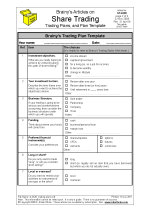
- Trading Styles
Understand your preferred style (intraday trader, short term
trader,
longer term trader, or investor).
See eBook Article ST-2410, "Trading Styles"
for a discussion.
[Toolbox members see the
full version of ST-2410 here.]
- Trading
Plan
Write out
a trading plan to describe "what" you want to invest in (eg.
shares,
CFDs, currencies, foreign exchange) and over what time
frames (short
periods, long periods).
See eBook Article ST-2420, "Trading Plans
and Template"
for a discussion.
[Toolbox members see the
full version of ST-2420 here.]
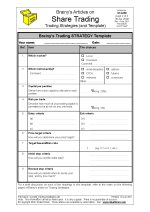 Trading
Strategy Trading
Strategy
Write
out your intended trading strategy - ie. the stock selection
criteria,
the entry signals, the exit criteria. Also your money
management,
portfolio management and risk management strategies
(including
stop-loss determination method). BUT, there is an assumption
here that
you understand enough about stock selection criteria.
It is possible
that you might need to learn more about Technical
Analysis methods.
See eBook Article ST-2430, "Trading
Strategies and Template"
for a discussion.
[Toolbox members see the
full version of ST-2430 here.]
- Nimble
Short Term Investing
The
Nimble Short Term Investing approach was pulled together (by
Robert
Brain) in 2014, and pondering many investing and trading
issues for
quite some time. There is no suggestion that the approach is a
winner,
and there is no suggestion that any one should adopt it. And
it is
possible that some of the finance industry professionals might
not like
some of the details.
See
more details about the Nimble Short Term Investing approach.
- Allocate time and time slots
|
A
note on
allocating time
The time to spend can be apportioned across
each of the following areas:
- Research time,
- Stock selection time,
- Optimising the entry,
- Managing the position,
- Monitoring all open positions,
- Managing the exit.
|
|
Why
do people
spend
so much time on it?
Different people will spend different amounts of time
on each of the
above aspects. Why?
Simple
- It's because they enjoy the activity. It's almost
like a favourite
hobby. For them, the journey itself is enjoyable.
See a discussion on this on the Toolbox web page Balance
the time on research and investing. |
One of the biggest
downfalls for many
new-comers is that they don't treat this activity seriously,
and they
don't allocate the time that it deserves. But the amount of
time is not
as important as having a routine.
The routine might be a specific
couple of hours on a certain day once each week, or it might
be more or
less often.
The important
point is that we need to be able to take advantage of market
opportunities as they arise, but more importantly we need to
know
whether our position is in profit or loss, and to exit our
position if
needed.
Without a regular (perhaps weekly) routine to do this, we
might be
throwing our money away.
- Understand the market and the instrument
You need to understand the market and instrument that you want
to
trade. It might be real shares on the share market, or CFDs on
shares
in the share market, or the currency markets (forex), or
options or
warrants on the share market. Or it might be the SPI (Share
Price
Index). It is
dangerous to play any game without knowing the rules.
See Article ST-2500 "Understanding
Share
Prices" (Toolbox member full version here.)
Perhaps study a
training course or seminar (eg. Brainy's
Share Market Secrets 101 seminar (aka Boot Camp).
- Your
"stock universe"
To
help increase the chance of success, and to stay focused,
there are a
number of considerations regarding your "stocks universe". If
you
choose to invest in Australian equities (ie. the share
market), then it
can be useful to narrow down the range of stocks in which you
might
invest. For example, you might choose to focus on any one of
the
following groups, or more than one of these groups (and see
more information on the "Your stock universe" web page):-
- Top 200 stocks - The XJO index (S&P/ASX
200).
- Top 500 stocks - The All Ordinaries index (XAO).
- The stocks in the mid-cap 50 index.
- The stocks in the Small Ordinaries index.
- The stocks in a particular sector (eg. financials,
health care, telecommunication stocks, etc.).
- Stock liquidity (see more details
here).
- And there are many other groupings to think about.
- Understand
your opponent and the counter-party
It
is very useful to understand as much as you can about the
other players
in the market - who are they? how big is their pocket? and
what rules
do they play by? You might be
surprised at how easy it is for a novice to come unstuck very
quickly
because some of the players bend the rules and don't play
fair. Don't
forget that there is always a counter-party on the other side
of your
trade, and it can be useful to understand who that might be.
- Understand
the market rules
It
is very useful to understand the rules for playing the game in
your
chosen market. And after understanding the rules, then realise
that
sometimes, some of these rules are bent by some of the
players. And
sometimes they get caught and punished, and sometimes they
don't. Just
because there are road rules that we are meant to obey on the
roads
(like speed limits, and obeying traffic lights and turn
signals),
doesn't mean that everyone abides by all the rules all of the
time.
|
(B)
Get ready
- Paperwork
It is very
important to have the appropriate paperwork ready to record
useful
information about your investing / trading activity. This
might be a
simple spread sheet to record the details of each buy and sell
transaction, with some way to track your overall results -
win/loss
ratio, average win size, average loss size, total profit (or
loss),
etc,. etc. It is important to give some thought to how you
might do
this. See more information below
about Trading Journals
and a Trading Diary.
- Trading practise
It
is important to practise before starting to trade for real.
This will
help to test out the emotions, as well as the strategy and the
recording paperwork. The practise might be back testing (see
items below), or a share market game like the twice yearly ASX
share market game. Also see Article ST-3100, "Trading
Practise"
[Toolbox members see the full article here].
- Back
testing
To gain
confidence with your documented trading strategy, it is very
wise to
test it out on past history. You could use the TradeSim
software to do this (with BullCharts).
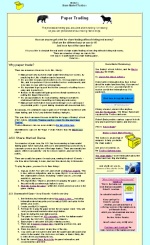 Paper
trading Paper
trading
Now that
you have some confidence with your trading strategy, test it
for real
by "paper trading". That is, go through the motions of
identifying stocks to trade, and hypothetically place your
trade by
recording your hypothetical trade details on paper (or in
the
computer), then at some future time, exit the trade and
record the
details. Monitor your success over a period of time (weeks
or months)
to gain more confidence that your strategy actually works.
See more
details about Paper Trading.
- Education
Identify any
missing knowledge or skill, and seek to address this. Join an
organisation of like-minded people to network with others and
to share
ideas and learn
from their experiences
(eg. the Australian
Technical
Analysts Association - ATAA).
- How to trade?
Determine whether you want to use a full-service broker to
give you
guidance and advice, or an online broker with no advice, or
somewhere
in between.
- Broker and Trading Account
Find an appropriate broker and/or service provider, and sign
up for a
trading
account.

- Charting software
To effectively
select quality stocks, and properly time the entry, you really
need
good quality charting software. This author prefers the
Australian BullCharts
charting software (and
as an authorised re-reseller can offer a
good deal). Many people find that a second computer monitor
can be
useful.
- Computer hardware
Provided we have a reliable internet
connection, we don't really need anything special to manage
our own
trades, unless we are serious enough to want to trade
intraday utilising current data. This might include a
"trading
platform" with specialised software (eg. WebIRESS which is offered by a
number of brokers), running on a computer with enough grunt to
perform
adequately.
- Review your
"ShareMarketReady" checklist (this web page) to see if you are
ready.
(C)
Risk and money management
- Risk and money management
Make sure you implement sound money and risk
management strategies.
If
investing / trading in stocks, consider preparing a watchlist
of only
quality companies in order to increase the chances of success
- avoid
high-debt companies and those with a history of poor
performance. Also
see
the "Managing
Risk" presentation), and the Toolbox web page Risk
management, and the following
eBook (PDF) Articles:
- Position
Sizing and Position Size Calculator
In
order to maximise the effectiveness of your trading, it is
important to
optimise the size of each trading position. That is, to
maximise your profits on winning trades, you should take out
the
largest possible position that your strategy and risk
management will
allow (perhaps up to a degree). Otherwise, your profits will
be smaller
than they could
be. And with proper money and risk management, the losses
should be no larger.
Some
simplistic research has shown that a position size needs to be
at least
about $1500 to $2000 in size, otherwise a modest amount of
brokerage
will take too large a bite out of the capital.
See the Toolbox web page on Optimising
position size.
See eBook Article ST-4400, "Position Sizing"
for details about position sizing.
[Toolbox members see the
full version of ST-4400 here.]
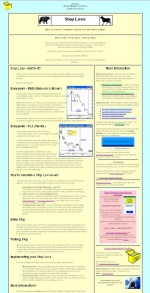 Exit
strategies Exit
strategies
It
is very important to have a plan regarding the possible exit
conditions
from a position. That is, what condition might trigger the
action to
sell part or all of a position? It could be any of the
following, for
example:- little price movement over a specific time period
(known as a
Time-based Stop); a weakening uptrend; a failure of an
uptrend; two
moving averages cross; a chart indicator shows weakening (eg.
RSI,
MACD, ADX, etc.); or a Stop Loss is triggered. See the
free
eBook Article TA-6030, "Exit strategies - Introduction",
and the Toolbox
web
page. Also, more details in the October 2013 monthly eNews email.
- Stop
Loss
If we want to limit our losses, and avoid the sometimes
catastrophic
falls in share prices, then it is vitally important to have a
Stop Loss
position determined for every position, and to action our stop
loss as
appropriate.
It
is customary to have an Initial Stop Loss to protect the
position until
it moves into profit, and then a Trailing Stop Loss that will
be moved
progressively higher to protect the accumulating profit as the
share
price moves higher.
See some initial information on the Toolbox Stop Loss
web page.
See Robert's eBook Article ST-4500, "Stop Loss"
for more details about that all important concept - the humble
Stop
Loss.
[Toolbox members see the
full version of ST-4500 here.]
- Portfolio management
Make sure to have a good way to record your trades and your
portfolio
positions.
- Risk
management
Be
sure to think through those things that could go wrong with
the
investing or trading activities - ie. have a "Plan B" ready.
Things
like a broken computer (power goes off, or internet goes
down). It will
be useful to have an alternate method for placing trades. This
might be
a laptop computer (with battery fully charged) and a separate
mobile
internet connection. Also a printed sheet of instructions, and
broker
phone number details, so that positions can be closed manually
by phone
without using a computer. If you do a serious risk analysis,
you might
ask yourself "what's the worst thing that can go wrong?". And
then
consider both the likelihood of each risk event, and the
seriousness of
the risk event if it does occur. Then work through the high
impact and
highly likely events and do something to mitigate the risk.
Then you
will be like a good Scout - Prepared.
- More information...
on these
topics is included in Brainy's eBook (PDF) Articles on Share
Trading - see
them
listed in the left-hand column on this web page (eBook
Articles
Table of Contents).... Also see: the archived
Monthly Toolbox eNews emails.
(D)
Trading -
"pulling the trigger"
- Trade
planning
Give careful consideration to any pending investment. This can
include
things like:
- The amount of possible Reward versus the Risk
(and the
Reward to
Risk Ratio).
- Using a Trade
Planning work sheet or calculator
to quickly consider different position size scenarios.
- The percentage amount of capital to be deployed,
and at risk
(see item above).
See Robert's eBook Article ST-5110, "Trade Planning"
for more information and tips regarding planning the trade.
[Toolbox members see the
full version of ST-5110 here.]
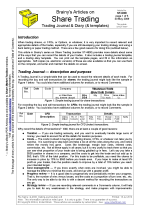 Logon, select, and trade
Logon, select, and trade
Proceed with caution.
- Keep
good records
It is vitally important to keep adequate records of all
transactions.
This might be for tax purposes, but also to enable a sound
periodic
review of performance to determine whether the strategy needs
to be
refined.
See Robert's eBook Article ST-5210, "Trading Journal
and Trading Diary"
for details about Trading Journals and Diaries. [Toolbox
members see
the
full version of ST-5210 here.]
- Manage the emotions
Be mindful
of the sweaty
palms and pumping
heart on your first few trades.
Not
able to sleep at night in case something goes wrong? Perhaps
the
position size is too large. Go back to the discussion above
about risk
management and reduce the position size to be a smaller
portion of the
overall capital (but remember to keep it large enough so that
the
brokerage fees don't kill it). Also see the Toolbox web
page Emotion and
psychology of the markets.
(E)
Trade Management - Monitor the positions and progress
reviews
- Monitor positions
Monitor and review open positions, and close out appropriate
positions
(ie. implement the Exit
Strategy when appropriate),
on a periodic basis according to your trading strategy. This
is
critical, in case the position is moving against you and you
ought to
consider closing the position. This might be on a daily basis,
or every
couple of days, or perhaps weekly. It needs to be thought
about, and
acted upon - rigorously.
- Periodic review of
positions
According to your trading strategy, review
your open positions and make adjustments as appropriate.
- Scale down a position
If a position has experienced significant growth, and is now a
much
greater value than when purchased, it might be over-weight in
the
portfolio. In which case it might be appropriate to sell a
portion in
order to bring the portfolio back towards a more balanced
situation.
- Periodic strategy review
According to your trading strategy, review both open and
closed
positions (ie. overall progress), and make any necessary
adjustments to
your trading plan and strategy.
(F) Investing /
Trading Strategies
For information on investing/trading strategies including some
concepts, some considerations, and some sample strategies
including
those listed below, with more details and lots of sample
strategies in
Brainy's eBook
(PDF) Articles on Share Trading
/ Investing (in the left-hand column, numbered ST-6xxx).
- Strategy considerations:
- Volume and
stock liquidity
- Finding
liquid stocks
- GICS Codes,
indexes and sectors
- Sample Strategies
- Break outs
- Correlation
- Robert
Weekly Watchlist
- Robert's
JB+AH Strategy
- Stan
Weinstein
- Alan Hull
- Daryl Guppy
- Nicolas
Darvas "How I made $2 million on the Stock Market".
WARNING:
Investing
in the share market does
expose you to the risk of financial ruin.
If
you proceed, please do so carefully.
Beware
the sharks in the ocean.
|



 Before you start investing
in the share market or share
trading, it is wise to adequately prepare.
Before you start investing
in the share market or share
trading, it is wise to adequately prepare.






 Trading
Strategy
Trading
Strategy 

 Logon, select, and trade
Logon, select, and trade